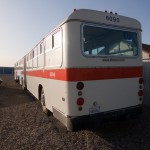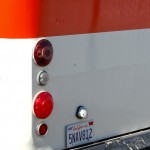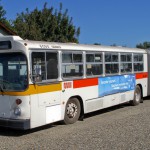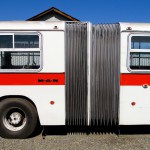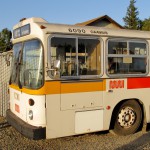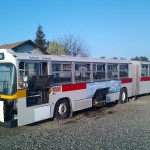Initial Sketch Concept
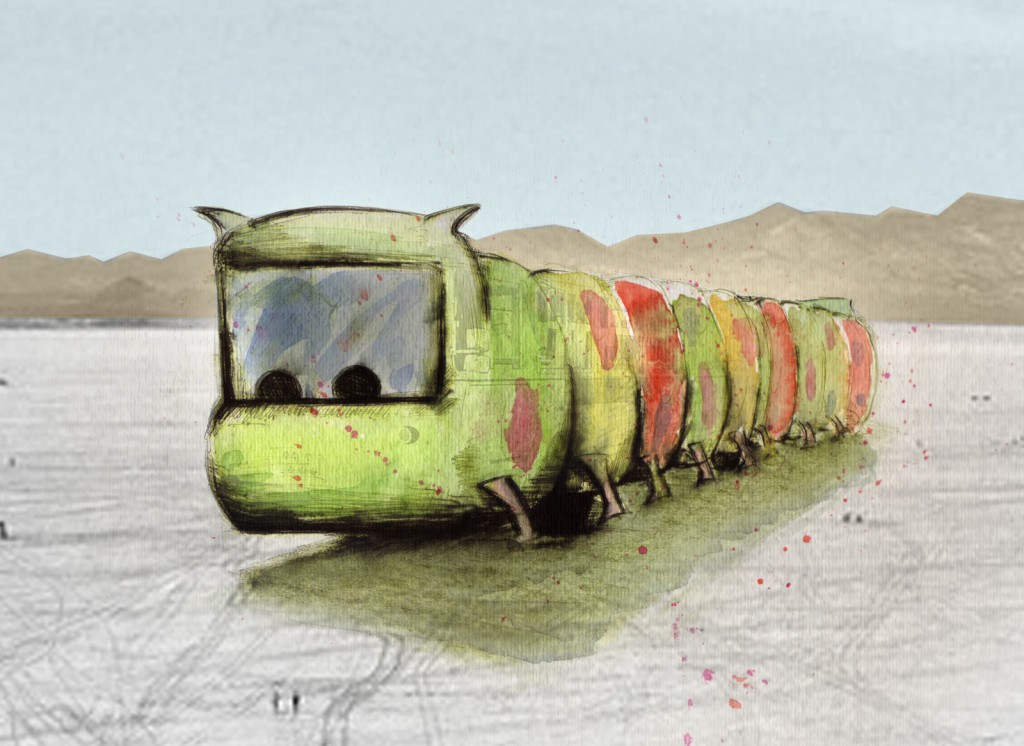
Initial Concept sketch for playapillar - a long bendy caterpillar slinking across the playa - Credit Sam
Playapillar Rendering
Playapillar Floorplan
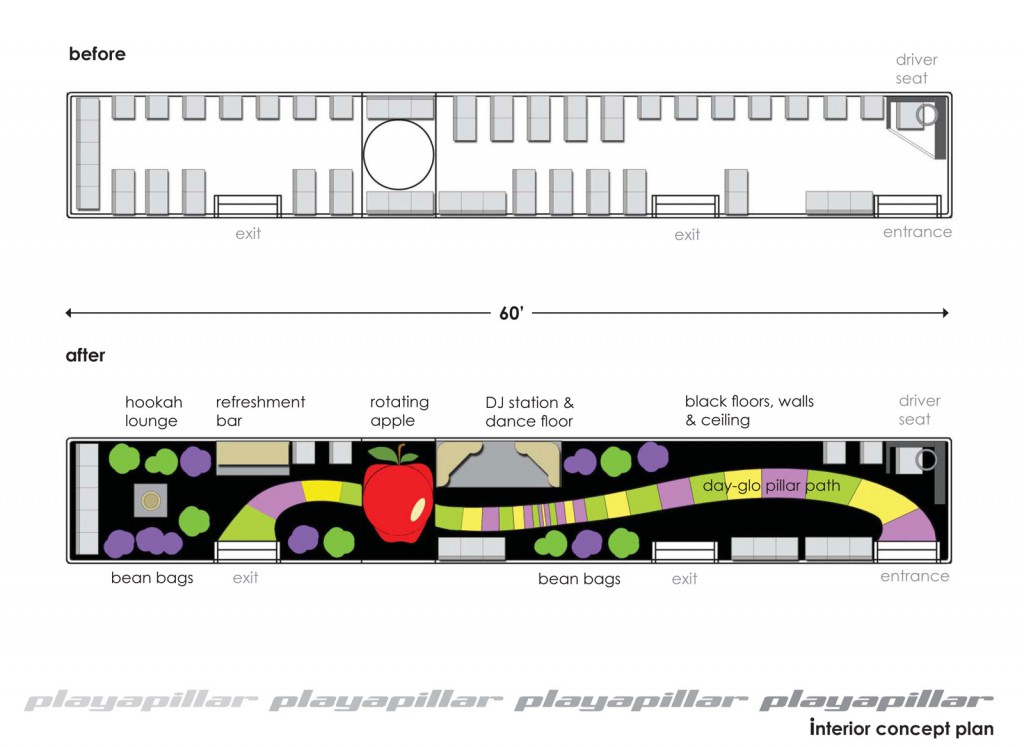
Playpillar interior Floorplan: Featuring silk cave, DJ and dance station, rotating apple, Playapillar Hookah Lounge and Seating for 55.
About the Mutation
PlayaPillar is a 60-foot long, green and blue bendy caterpillar. It started its life as a San Francisco MUNI articulated bus.
(1) The exterior is made up of a series of bent ribs, across which a striped, blue and green “skin” will be stretched into a gigantic, ribbed tube. The PlayaPillar “head” features giant antennae protruding from the top, with a disco ball attached at the end of each and a playful “mouth” that serves as a windshield for driving operations. The sides have tiny “feet” that dangle to the ground and the “tail” is a stubby cone at the end of the art car.
(2) The PlayaPillar interior features a silk cave with seating, a DJ/dance area, a rotating apple, an area for refreshments, a hookah lounge, and a day-glo “PillarPath”.
(3) The skin of the Playapillar will have portholes with flaps that can be opened to allow passengers to see out onto the Playa or closed to make for a more surreal experience.
(4) The capacity of the Playapillar is 55 seated or 110 standing, plus a driver.
(5) All drivers will wear bus driver uniforms and treat boarding Burners as if they were boarding a regular bus. Transfers may be issued, stop announcements will be made and periodic service announcements will be made over the transit sound system. Drivers will offer helpful information about navigating the playa and making transfers to other playa transit systems to passengers. A sign near the driver will indicate: “Information Gladly Given, but Safety Requires Avoiding Unnecessary Conversation”.
(6) In conjunction with the PlayaPillar Art Car a network of 5-7 bus shelters modeled after SF MUNI bus shelters will be deployed across Black Rock city and unpredictable service will be provided connecting them. Several sub-groups of Illumination village have agreed to help with the shelter project and a demonstration shelter has been constructed.
(7) An in-vehicle information system will be deployed using a discarded LED scrolling sign that may or may not properly indicate upcoming stops, transfer opportunities, and other Black Rock City service announcements.
Lighting Plans
The exterior of the PlayaPillar will be lit by fluorescent lights behind the PlayaPillar skin to make the entire length of the PlayaPillar glow. The antennae disco balls will be illuminated with spotlights, causing a flecked, disco-like pattern to be projected around the front of the bus.
The interior will be lit with dimmable rope-lights, dangling LED “silk” and an interior disco ball. Blacklight will be used in areas to make the day-glo PillarPath really stand out.
All on-board electronics will be powered by an on-board power inverter and a generator placed at the rear of the vehicle. The generator will be properly exhausted and sound insulated.
Mutant Vehicle Intent
We intend to operate the PlayaPillar as a form of Playa Transit – we can accommodate a lot of citizens and transport them around the city. The PlayaPillar will operate long hours and seek to accommodate as many different citizens of Black Rock City as possible. For non-passengers, the PlayaPillar will be a surreal, larger-than-life caterpillar crawling and bending across the playa. The PlayaPillar will have a very positive impact on Black Rock City.
Design Safety
Although the interior and exterior will be mutated, PlayaPillar will retain all safety features native to the original vehicle design, including:
* Openable windows with safety exits on both sides.
* Three escape hatches on the roof of the vehicle.
* Vertical and horizontal hand railings running the length of the vehicle allowing passengers to safely stand while riding the vehicle.
* A working in-vehicle announcement system that can be used for issuing safety announcements
* Three sets of doors for quick egress
* There are three steps leading from the ground up to the floor of the vehicle on each of three doors. PlayaPillar crew will, at all times, be posted at each entrance to ensure safe boarding and alighting.
* All other safety features native to the original bus will remain intact, including brakes, emergency exits, and sensor shut-offs.
* A fire extinguisher will be kept near the drivers seat at all times, and drivers will be trained on fire fighting techniques.
Operating Procedures
All PlayaPillar Drivers will be fully licensed with a California Class B commercial drivers license with Air Brakes Endorsement and Passenger certificate. At all times, at least three crew members will be present in uniform to assist in vehicle operation.
Starting the Vehicle – A thorough pre-trip vehicle inspection will be made prior to starting the vehicle each time:
* Visually inspecting underneath the vehicle and behind each set of wheels for debris and people
* Checking the vehicle for damage
* Inspecting all three sets of doors to make sure they function properly
* Testing the vehicle’s exterior lighting systems
* Testing the vehicle’s brake systems
Operating the Vehicle – A PlayaPillar crew member will be present outside the vehicle to do a visual inspection to make sure the sides of the vehicle are clear and no one is in danger when the vehicle starts moving. When making a tight corner, a crew member will disembark to help marshal the vehicle around the corner. When in reverse, a crew member will be present behind the vehicle and visible to the driver to marshal the vehicle. In general, tight cornering and reversing will be avoided.
Boarding and Alighting – When departing the driver will make an announcement notifying passengers the vehicle is about to move and informing them of the destination (if known). A crew member will signal to the driver that all doors are clear and secure and an indicator light on the dashboard will let the driver know it is safe to move forward. When arriving at a destination, the driver will announce the location and the approximate duration of the stop. Crew members will be positioned at the middle and rear doors for crowd control and will limit the number of passengers to a safe number.
Storing the Vehicle – When a drivers shift has completed, they will shut off the vehicle and secure it for the night. There is no ignition key, but the vehicle startup process is sufficiently difficult such that an unauthorized person would not be able to start the vehicle. A secret shutoff switch inside the dash ensures that no one can get the vehicle into gear without knowing the vehicle systems.
Entry/Exit Procedures
Like a regular bus, PlayaPillar has three entrance points via swinging doors. There will be slits in the exterior skin of the vehicle to accommodate access at these points. Crew members will be positioned at the middle and rear doors and the driver is near the front door to assist passengers and control access to the PlayaPillar. There will be no other types of access to the vehicle and roof access will not be allowed.
Fuel Type
The vehicle is powered by diesel. The powertrain is stock and identical to that used by the original vehicle. Although by itself diesel fuel is not particularly environmentally friendly, the fact that we can transport upwards of 100 passengers at a time means that we will have very low fuel consumption per passenger.
Vehicle Info
1984 articulated MAN
Make: MAN Company Website
Model: SG310-18-3A
Serial:EC720800
Fleet #: 6090 SF. Muni
Engine: MAN pancake
Fuel: diesel
Transmission: 3 sp. Allison auto.
Top speed: 55 mph.
Starter: pneumatic
Length: 60 ft.
Width: 102 in.
Capacity: 105
Vehicle History
This vehicle was built in 1984 in North Carolina for San Francisco MUNI by the MAN Corporation. It operated on the 38/38L Geary route in San Francisco until 2002 when the entire MAN fleet was decommissioned and replaced with a fleet of Neoplan AN460 articulated busses.
The vehicle was auctioned to a Hollywood bus rental company where it starred in the newer version of “The Italian Job”, a Tide commercial and possibly one Nelly music video.
This vehicle is a sister vehicle to the NautilusX, which was SF MUNI fleet #6020 has served the citizens of Black Rock City since 2002.


